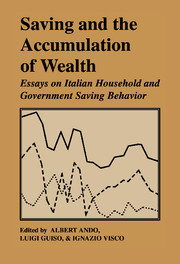Book contents
- Frontmatter
- Contents
- Foreword by Antonio Fazio
- List of contributors
- List of figures
- List of tables
- Acknowledgments
- Introduction
- I Saving trends, government deficit and demographic changes
- II Life-cycle saving and precautionary motives
- 5 Young households' saving and the life cycle of opportunities. Evidence from Japan and Italy
- 6 Dissaving by the elderly, transfer motives and liquidity constraints
- 7 Earnings uncertainty and precautionary saving
- 8 Risk sharing and precautionary saving
- III Borrowing constraints, intergenerational transfers and bequests
- Appendixes
- Index
7 - Earnings uncertainty and precautionary saving
Published online by Cambridge University Press: 05 May 2010
- Frontmatter
- Contents
- Foreword by Antonio Fazio
- List of contributors
- List of figures
- List of tables
- Acknowledgments
- Introduction
- I Saving trends, government deficit and demographic changes
- II Life-cycle saving and precautionary motives
- 5 Young households' saving and the life cycle of opportunities. Evidence from Japan and Italy
- 6 Dissaving by the elderly, transfer motives and liquidity constraints
- 7 Earnings uncertainty and precautionary saving
- 8 Risk sharing and precautionary saving
- III Borrowing constraints, intergenerational transfers and bequests
- Appendixes
- Index
Summary
Introduction
The idea that people accumulate assets to face unexpected drops in income dates back to Friedman (1957). Later studies by Leland (1968), Sandmo (1970) and Drèze and Modigliani (1972) stated the theoretical conditions about preferences under which an increase in uninsurable risk leads to higher saving. Recent research has further sharpened the theory of precautionary saving. Zeldes (1989), Caballero (1990) and Weil (1993) have extended the two–period framework used by earlier authors to multi–period models and established that the amount of precautionary saving increases in response to an increase in the variance of the shocks of the income generating process and in its degree of persistence. Kimball (1990) has shown that if people have decreasing prudence, precautionary saving declines as individual wealth rises.
Precautionary saving has several empirical and policy implications. Zeldes (1989) points out that precautionary saving may explain some of the consumption “puzzles”, such as the excess sensitivity of consumption to anticipated income fluctuations, the growth of consumption even in the presence of low real interest rates and the slow rate of wealth decumulation of the elderly. If uncertainty affects consumer behavior, government insurance programs and tax policies may reduce individual risks and may increase welfare (Barsky, Mankiw and Zeldes, 1986). Since generation specific risks may be offset by a chain of intergenerational transfers, a finding that consumers react strongly to uncertainty would therefore question not only the quadratic utility model, but Barro's (1974) dynastic model as well.
- Type
- Chapter
- Information
- Saving and the Accumulation of WealthEssays on Italian Household and Government Saving Behavior, pp. 214 - 245Publisher: Cambridge University PressPrint publication year: 1994



